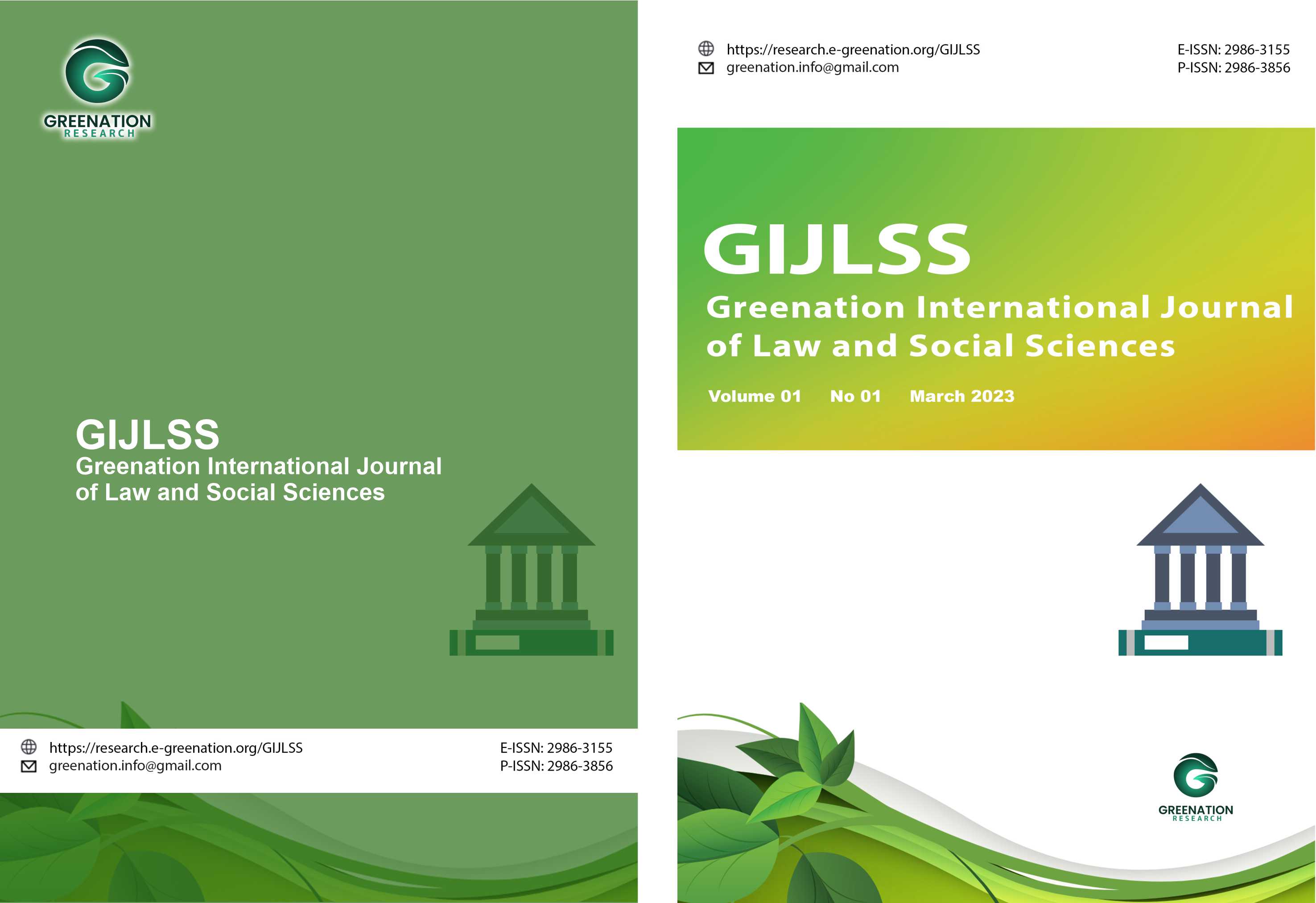A Critical Analysis of Carbon Trading Policy as an Action for Adaptation and Mitigation of Climate Change from the Perspective of Indigenous Peoples in Indonesia
DOI:
https://doi.org/10.38035/gijlss.v3i3.589Keywords:
Carbon Trading, Climate Changes, Adaptation and Mitigation, Indigeneous PeoplesAbstract
The climate crisis, biodiversity loss and pollution are three planetary crisis facing humanity today. Studies show that the primary source of these crises is the massive emissions released by developed/industrial countries over the past decades through energy, agriculture, forest and land conversion, industrialization, and waste. In 2015, the world’s nations committed to addressing the climate crisis, in accordance with the Paris Agreement. By passing Law Number 16 of 2016 about the Paris Agreement on the United Nations Framework Convention on Climate Change (UNFCCC), Indonesia, a party to the UNFCCC Conference of the Parties, ratified the Paris Agreement. Presidential Regulation Number 98 of 2021, which addressed the Implementation of Carbon Economic Values for Achieving Nationally Determined Contribution Targets and Control of Greenhouse Gas Emissions in National Development, was subsequently issued in response to this policy. The Indonesian government has disregarded the rights of Indigenous Peoples in favor of a carbon trading mechanism centered on forests and land, rather than reaffirming its commitment to combating climate change. This study critically examines carbon trading programs within the perspective of climate change adaptation and mitigation using a qualitative methodology grounded in literature analysis, particularly from the perspective of Indigenous Peoples. Findings indicate that carbon trading-based conservation models often contradict Indigenous Peoples' own conservation practices. In fact, in many regions, such projects trigger conflict, land grabbing, and the potential criminalization of Indigenous Peoples. Furthermore, carbon trading fails to address the root causes of the climate crisis. The offset scheme instead allows industrial actors to continue releasing emissions on a large scale. Therefore, this mechanism is inconsistent with the principles of climate justice, the fulfillment of Indigenous Peoples' rights, and the global obligation to curb global warming.
References
Aliansi Rakyat untuk Keadilan Iklim. (2023). Kertas posisi Koalisi Keadilan Iklim: Mendesak negara segera menyusun UU Keadilan Iklim (Rev. 5). WALHI. https://www.walhi.or.id/uploads/buku/Kertas%20Posisi%20Koalisi%20Keadilan%20Iklim_Rev5.pdf
Arizona, Yance (2010), Antara Teks dan Konteks; Dinamika pengakuan hukum Terhadap Hak Masyarakat Adat atas Sumber daya Alam di Indonesia, Jakarta: HuMa.
Binawan, A. A., & Sebastian, T. (2012). Menim(b)ang keadilan eko-sosial (Kertas Kerja EPISTEMA No. 07/2012). Jakarta: Epistema Institute.
Fraser, N. (1998). Social justice in the age of identity politics: Redistribution, recognition, and participation (WZB Discussion Paper No. FS I 98-108). Berlin: Wissenschaftszentrum Berlin für Sozialforschung. https://www.ssoar.info/ssoar/handle/document/12624
Intergovernmental Panel on Climate Change (IPCC). (2021). Climate change 2021: The physical science basis. Cambridge University Press.
Irianto,Sulistyowati (2012) “Memperkenalkan Kajian Sosio-legal dan Implikasi Metodologisnya”, dalam Kajian Sosio-Legal: Seri Unsur-unsur Penyusun Bangunan Negara Hukum (hlm.2). ed. Adriaan W Bedner, et. al. Jakarta: Universitas Indonesia, Universitas Leiden, Universitas Groningen.
Jamin, Mohammad dkk (2015), Politik Hukum Pengakuan Kesatuan Masyarakat Hukum Adat di Indonesia, Surakarta: UNS Press.
Magnis-Suseno, F. (2005). Pijar-pijar filsafat. Yogyakarta: Kanisius
Rahmawati, D. A., Syafruddin, S., & Suryanto, H. (2023). Carbon trading and environmental justice: A juridical examination of fairness in Indonesia’s emissions reduction initiative. West Science Law and Human Rights Journal, 2(1), 45–57. https://wsj.westsciences.com/index.php/wslhr/article/view/1373
Rawls, J. (1971). A theory of justice. Cambridge, MA: Harvard University Press
Siagian, U. A. (2025, September 20). Mewujudkan keadilan ekologis. Kompas.id. https://www.kompas.id/artikel/mewujudkan-keadilan-ekologis?open_from=Section_Terbaru
Siagian, U. A., & Arman, M. (2023). Kertas posisi perdagangan karbon 2023 (Rev. final). Aliansi Masyarakat Adat Nusantara (AMAN). https://www.aman.or.id/files/publication-documentation/46147Kertas_Posisi_Perdagangan_Karbon_2023%20-%20fin.pdf
Simarmata, Rikardo dan Steni, Bernadinus (2017), Masyarakat Hukum Adat Sebagai Subjek Hukum: Kecakapan Hukum Masyarakat Hukum Adat Dalam Lapangan Hukum Privat Dan Publik. (Bogor: The Samdhana Institute)
Soekanto, Soerjono (2014), Pengantar Penelitian Hukum, Jakarta: UI Press
Taufik, M. (2013). Filsafat John Rawls tentang teori keadilan. Mukkadimah: Jurnal Studi Islam, 19(1), 1–14.
United Nations Development Programme (UNDP). Indonesia Climate Promise. Accessed on Oct 7th, 2025, retrieved from: https://climatepromise.undp.org/what-we-do/where-we-work/indonesia
Widowati, Dyah Ayu dkk (2014). Pengakuan Dan Perlindungan Hak Atas Tanah Masyarakat Hukum Adat Di Kawasan Hutan. (Yogyakarta: Pusat Penelitian dan Pengabdian kepada Masyarakat, Sekolah Tinggi Pertanahan Nasional)
Downloads
Published
How to Cite
Issue
Section
License
Copyright (c) 2025 Muhammad Arman, Rineke Sara

This work is licensed under a Creative Commons Attribution 4.0 International License.
Copyright :
Authors who publish their manuscripts in this journal agree to the following conditions:
- Copyright in each article belongs to the author.
- The author acknowledges that the Greenation International Journal of Law and Social Sciences (GIJLSS) has the right to be the first to publish under a Creative Commons Attribution 4.0 International license (Attribution 4.0 International CC BY 4.0).
- Authors can submit articles separately, arrange the non-exclusive distribution of manuscripts that have been published in this journal to other versions (for example, sent to the author's institutional repository, publication in a book, etc.), by acknowledging that the manuscript has been published for the first time at GIJLSS.
























